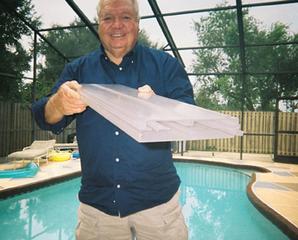SARASOTA, FLA. — A general contractor from Florida who patented a clear PVC wall form that encapsulates concrete sees a long list of potentially life-saving applications for his stay-in-place building system, as well as benefits for everyone involved with the construction, be it a conventional crew, inspectors or soldiers in the field.
PVC-encased concrete can stand up to a 6.0-magnitutude earthquake or a 2,200-pound bomb blast, according to inventor Joe Lanc (pronounced Lance) of Sarasota, Fla., who said he has computer test results from the Space Alliance Technology Outreach Program (SATOP) to prove it, at least in theory.
Lanc, 77, calls his invention the Concrete Plastic Unit (CPU). He said houses, businesses, offices and military posts made of cement fortified with the third most-widely used plastic will fare better in hurricanes, tornadoes, wild fires, floods and terrorist attacks, too.
He designed seven profiles of the clear PVC forms for poured-in-place concrete, which he said is more versatile and error-resistant than other non-transparent, polymer building systems on the market. The forms, which have a blue tint from additives, can be interchanged or modified to make insulated, steel- or fiber-reinforced walls, floors and roofs of what would essentially be all-hazard structures.
"When you encapsulate concrete in plastic you can save lives, prevent total collapse of walls and give people time to get to safety," Lanc said in a telephone interview. "I think plastic is the whole secret to new construction using concrete."
Other possible applications include storing nuclear materials, shielding embassies and military bases, making sea walls, protecting beaches from oil spills, building fish-farm tanks, repairing levees, and replacing sandbags for flood control. Fill the PVC-extruded forms with sand instead of cement and set them along rivers about to crest. When the threat recedes, remove the sand and store the wall forms for future use.
Lanc came up with the idea for the CPU (U.S. Patent No. 6,167,669) after seeing firsthand the aftermath of Hurricane Andrew in 1992. According to the National Weather Service, the Category 5 storm left dozens dead and hundreds of thousands homeless, and caused more than $26 billion in damage when it touched land in the Bahamas, Florida and Louisiana. Struck by the loss of life and property, Lanc got to thinking about a better way to protect the people and possessions in places vulnerable to natural and man-made disasters.
Building on an idea
Lanc's solution consists of clear PVC forms that are one-eighth-inch thick and divided into compartments, which can be filled with a mix of insulated, aerated foam concrete and high-strength, fiber-reinforced concrete. They are 8-inches high and would be shipped in 16- to 20-foot-length sections that are lightweight and can be cut to any length or angle on site. The tops and bottoms of the forms have holes to add concrete mixes and seven-eighths-inch PVC reinforcing bars every 4 inches. They are joined by sliding them together and welding the corners together with plastic.Different concrete mixes can be poured into the forms at the same time. The next layer is stacked horizontally on top. The clear forms allow contractors to see where to install PVC conduit, service boxes, flexible cross-linked PE plumbing, and other utilities and wiring. Building inspectors can confirm with a glance that rebar is properly place and the concrete has no voids.
"I see the day that the building inspectors may not even have to do on-site inspections," Lanc said. "They can review at their office desk on a computer screen and zoom in to check items that might otherwise be overlooked. If the building fails, it would not be caused by shoddy inspections."
Drywall isn't needed, but all finished CPU walls must be coated with a fireproof polymer-based cement coating that can be any color or texture. The resulting structures would have walls that are not only strong but well-insulated thermally and acoustically, waterproof, airproof, and resistant to corrosion, mildew, mold and pests.
Move over expanded polystyrene, at least as an insulator and sound barrier for concrete, said Lanc, who has worked 47 years in construction.
"The cellular concrete has basically the same, but better, properties as that of EPS, but is 100 times stronger," he said.
By protecting the concrete mix with a clear plastic shell, Lanc said you get the first big improvement to concrete since the 1880s, when Ernest Ransome devised a reinforced-concrete building technique.
"The method of embedding steel in concrete to give it more tensile strength has been used ever since," Lanc said, adding it's time for an upgrade.
"Concrete structures are failing all over the world. The steel is corroding and the concrete is deteriorating due to moisture and air intrusion. Encapsulating concrete in plastic will stop this slow march of destruction," Lanc said. "My system offers a method to make concrete structures waterproof and add not only tensile strength but something that has never been done before: adding compressive strength to the sides of the concrete wall."
For the roof, a patented, 12-inch-thick EPS system called InsulDeck would be used, Lanc said. It could be stamped to resemble traditional roofs.
A structure as large as 2,000 square feet could be completed in a month by a crew of four and a supervisor, according to Lanc, who said he isn't sure of the cost, but describes his building system as inexpensive because of what it doesn't need: "You eliminate drywall, siding, insulation, pre-cast lintels and so many things. All that adds up and I believe when you get the system together it will save money," he said.
Financing sought
The CPU building system holds many promises when it comes to cost, energy efficiency and disaster protection.Lanc got to test his idea in 2010 — nine years after getting the patent — with a finite element method computer analysis at SATOP, which is an alliance of 45 space companies, universities and NASA centers. Professionals in the alliance volunteer their time and expertise to speed the transfer of technology to small businesses.
The results show a CPU wall could withstand a moderate earthquake — the kind that is felt by everyone and damages poorly constructed buildings — and sustain no damage if 2,200 pounds of TNT was detonated 7 feet away.
While Nuform Building Technologies in Ontario, Canada, and Dincel Construction Systems of Erskine Park, Australia, both offer durable wall-forming systems, Lanc said their sections are installed vertically. He said the benefit of horizontal wall forms is a fast, familiar way to lay concrete blocks.
"When I got my material to build my test wall, we assembled a 16-foot section in less than 3 minutes. That was the same as laying 12 concrete blocks," Lanc said.
He has been invited to demonstrate his CPU building system at a research lab at Tyndall Air Force Base in Panama City, Fla. He said researchers are interested in military applications for blast protection as well as easy transport and storage. The wall forms could be filled with steel-reinforced dry sand and quickly set up by two or three people using only hand tools.
"There's a grave need for better modular protection systems in combat situations," said Lanc, a U.S. Army veteran. "The PVC wall forms could protect against direct and indirect fire, shoulder-fired rockets and other enemy threats. Then, they can be disassembled, cleaned out and restacked for reuse."
Before he can accept the Tyndall AFB invitation, Lanc is seeking grants and other financial assistance to build a few walls to demonstrate.
"I built one test wall with two of the seven profiles and it took me three years to save up enough money to get the dies and sizers made," Lanc said. "I need roughly $200,000 for the seven profiles and to get this to market. A company in Pennsylvania will make them and produce enough material for me to build six walls. I got a special deal after Hurricane Sandy hit [in 2012] and damaged the owner's house in New Jersey."
Lanc said he hopes a demonstration of his building system will put him on the radar of the Department of Defense, particularly the U.S. Army Construction Engineering Research Laboratory, or the R&D center for the U.S. Army Corps of Engineers.
Merit for the military
One researcher interested in Lanc's building system is Auburn University's James Davidson in Alabama, a faculty member who teaches civil engineering and assists the military with studying the effects of blast loads on structures. Davidson has ties to the Tyndall researchers that go back to 1996 and his students have a sort of partnership with them."We do a lot of the numbers stuff and some modeling," Davidson said. "They build it and blow it up. It all comes together as a good research project in the end."
In 2006, the professor helped Tyndall researchers test one of the vertical building systems used by the military. They were, and still are, looking for ways to minimize the blunt trauma and penetration injuries caused by explosive devices. Most fatalities and injuries related to external bomb blasts are due to collapsed walls, shattered windows, and objects propelled at high velocities — not the pressure, heat or bomb-container fragments resulting from detonation.
The 2006 study concluded that stay-in-place PVC forms provide "significant" blast protection compared with concrete walls without polymer constituents.
Davidson said he thinks the idea of clear wall forms for horizontally built structures also deserves consideration and he wonders if there would be some benefit with fenestration features, such as windows and doors.
"Mr. Lanc's approach is a little different in the sense that [it is aligned] with the way we construct masonry — horizontally — and that should have some advantages if you do one layer at a time," Davidson said. "I have to stop short of being perfectly firm about it because I haven't constructed anything with this approach, but I think it has some merit.
"We're looking for construction methods that help install facilities more quickly and of course as economically as possible," he added. "The idea of having these preformed plastic units is of interest because theoretically you can set those up and no matter where in the world you are you can backfill them with concrete or something like it."
However, research dollars are limited and government agencies can't just pick and choose what products to study, let alone which ideas to pursue.
"They don't just grab products and test them," Davidson said. "This is part of a research program and they have to have a certain set of boxes checked before they can even interact. It's not a straightforward thing to do."
An innovation at the idea stage has hurdles.
"If you just have an idea, it's difficult until someone helps you take that idea to full-scale demonstrations. It's extremely difficult right now," Davidson said. "There have been a lot of cutbacks in that area. It's a struggle. I hope Mr. Lanc finds that person and maybe some private-sector funding to help him take it further."
If he does, Davidson said he will offer his insight as a force protection researcher. He also can help arrange a meeting with Tyndall government engineers.
"They are always looking for good ideas and this fits with that," Davidson said.
In the meantime, Lanc said it's not easy seeing green buildings get so much attention and financing. He questions the emphasis on reducing the environmental impacts of buildings while so many structures and people are vulnerable to the forces of nature and man.
"The LEED [Leadership in Energy and Environmental Design] movement needs to realize that they need plastic to develop a stronger disaster- and water-proof solid-concrete structure before they bring in all the green stuff," Lanc said. "And, the public needs to know there's a better, inexpensive way to build solid-concrete, safe houses that they don't have to flee and [that] will still be there if they are forced to evacuate."






